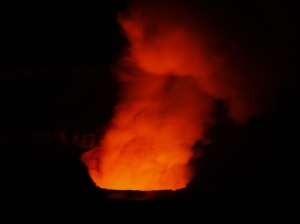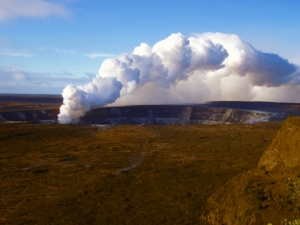Kīlauea Eruption Status
Reprinted from here.
Photo by Donnie MacGowan

Kīlauea Volcano continues to be active. A vent in Halema`uma`u Crater is erupting elevated amounts of sulfur dioxide gas and very small amounts of ash. Resulting high concentrations of sulfur dioxide in downwind air have closed the south part of Kīlauea caldera and produced occasional air quality alerts in more distant areas, such as Pahala and communities adjacent to Hawai`i Volcanoes National Park, during kona wind periods. On September 5, scientists observed a 50-m- (160 ft) diameter lava lake about 100 m (330 ft) below the vent rim on the floor of Halema`uma`u; the lava cannot be seen from the rim of Halema`uma`u Crater or Jaggar Museum Overlook. There have been several small ash-emission events from the vent, lasting only minutes, in the last week.
Pu`u `Ō`ō continues to produce sulfur dioxide at even higher rates than the vent in Halema`uma`u Crater. Trade winds tend to pool these emissions along the West Hawai`i coast, while Kona winds blow these emissions into communities to the north, such as Mountain View, Volcano, and Hilo.
Lava continues to erupt from fissure D of the July 21, 2007, eruption and flows toward the ocean through a well-established lava tube. The ocean entry at Waikupanaha was interrupted twice in the past week in response to back-to-back deflation/inflation (DI) events at Kilauea summit. There were small, short-lived breakouts on the coastal plain early in the week as the eruption recovered from the two pauses in lava supply. The ocean entry had recovered by the second half of the week and hosted frequent small littoral explosions.
Be aware that active lava deltas can collapse at any time, potentially generating large explosions. This may be especially true during times of rapidly changing lava supply conditions. Do not venture onto the lava deltas. Even the intervening beaches are susceptible to large waves generated during delta collapse; avoid these beaches. In addition, steam plumes rising from ocean entries are highly acidic and laced with glass particles. Check Civil Defense Web site (http://www.lavainfo.us) or call 961-8093 for viewing hours.
Mauna Loa is not erupting. Four earthquakes were located beneath the summit this past week. Continuing extension between locations spanning the summit indicates slow inflation of the volcano.
Four earthquakes beneath Hawai`i Island were reported felt within the past week. A magnitude-2.0 earthquake occurred at 8:21 p.m., H.s.t., on Thursday, September 18, 2008, and was located 3 km (2 miles) southeast of Kilauea summit, at a depth of 3 km (2 miles). A magnitude-4.3 earthquake occurred at 5:59 p.m. on Friday, September 19, 2008, and was located 6 km (4 miles) northeast of Ka`ena Point on Kilauea's south flank at a depth of 10 km (6 miles). A magnitude-3.0 earthquake occurred at 7:49 a.m. on Tuesday, September 23, 2008, and was located 32 km (20 mile) northeast of Honoka`a at a depth of 32 km (20 miles). A magnitude-2.2 earthquake occurred at 7:25 a.m. on Wednesday, September 24, 2008, and was located 4 km (3 miles) northeast of Kukuihaele at a depth of 30 km (19 miles).
Visit our Web site (http://hvo.wr.usgs.gov) for daily Kīlauea eruption updates, a summary of volcanic events over the past year, and nearly real-time Hawai`i earthquake information. Kīlauea daily update summaries are also available by phone at (808) 967-8862. Questions can be emailed to askHVO@usgs.gov.
Photo by Donnie MacGowan

For more information on touring Hawaii in general and the Big Island in particular, go here and here.

No comments:
Post a Comment